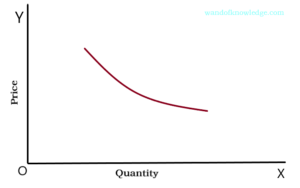Demand and Demand Curve
Meaning of Demand
By demand we mean the amount of some commodity which an individual wishes to purchase in a given market in a given period of time at a given price. According to Benham, the demand for anything, at a given price, is the amount of it which will be bought per unit of time at that price. Demand means always demand at a price, the term has no significance unless a price is stated or implied.”
Demand Curve
The relation between price and demand is inverse. When there is a rise in price the amount demanded falls and when the price falls, the amount demanded increases. When this relationship between price and amount demanded is shown geometrically it is called demand curve. Y1 According to Benham, “the relation between the price and the amount bought can be plotted on a diagram as a demand curve. In figure the demand curve is shown by DD curve. The quantity demanded is measured along X-axis and the corresponding price per unit along Y-axis.

If perpendiculars are drawn from points indicating quantities demanded O on OX and corresponding price on OY the meeting points of these perpendiculars will be on a curve. This curve is slopping has a negative slope. It indicates that, if other things remain the same, more units of the commodity will be bought at a lower Demand price than at a higher price.
The demanded curve can be of any shape. It can be a straight line or convex curve or a concave curve. Most of the demand curves are not straight lines. They are either convex or concave partly one and partly another. There is no particular shape which is typical.
Other things remain the same:
While farming a demand curve we presume certain conditions as given. The following are the conditions which we take as constant:
- The tastes and preferences of consumers do not change.
- Income of the buyers remains unchanged.
- The price of other related commodities does not change.
- We ignore the discontinuous change. So price-demand relationship is considered continuous.
- No individual consumer is in a position to influence the price.
Why is the demand curve sloped downwards?
This happens because of various reasons-
- When the price of a commodity falls a person can offer to buy more units of a commodity. This is so because the consumer equalizes the marginal utility of money with the marginal utility derived from the consumption of that unit. He stops purchasing at that point where the marginal utility of money spent is equal to the marginal utility derived from the consumption of the last unit of the commodity.
- When the price becomes lower the marginal utility received from the commodity become higher than the marginal utility of money. In order to bring it at equal level it is necessary that more units of the commodity be purchased so that both the utilities become equal.
Exceptional Demand Curve
Although the demand curve slopes downwards in almost all the cases but in certain circumstances the demand curve rises upwards. It means that the demand increases’ with an increase in price and decreases with the decrease in price. Some cases have been mentioned by many economists.
Sir Robert Giffen of the U.K. realized that the demand curve for inferior goods rises upwards. When superior goods, which are high priced, become more costly, consumers have to shift to inferior goods which are cheaper. The demand for inferior goods becomes more even when the price rises. Giffen gave an example of the situation prevailing in England in the 19th century. The price of wheat was rising and so the labour were not able to consume eggs, meat etc. which were high priced. So that had to consume more wheat even when the price wheat was in sing. This situation is known as “Giffen Paradox.”
Important links
- Business Economics- Meaning, Definition, Scope & Nature
- Role and Responsibilities of Business Economist
- Operation of Law of Diminishing Marginal Utility- Causes, Exception
- Law of Diminishing Marginal Utility
- Significance of Business Economics in Decision Making
Disclaimer: wandofknowledge.com is created only for the purpose of education and knowledge. For any queries, disclaimer is requested to kindly contact us. We assure you we will do our best. We do not support piracy. If in any way it violates the law or there is any problem, please mail us on wandofknowledge539@gmail.com
